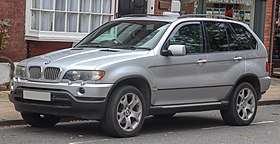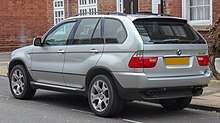BMW X5 (E53)
The BMW E53 is the first-generation BMW X5 mid-sized luxury crossover SUV. It was produced from 1999-2006[2] and was replaced by the BMW E70. The E53 was developed at a time when BMW still owned Land Rover and as such shares many components and designs with both the Land Rover Range Rover L322 model (specifically the Hill Descent System and Off Road Engine Management system) and the BMW E39 5 Series (specifically engines and electronic systems). The entire in-car entertainment system (Radio Function, Navigation System, Television and Telecommunications systems) are shared with other BMWs and L322.
| BMW X5 (E53) | |
|---|---|
 | |
| Overview | |
| Manufacturer | BMW |
| Production | 1 September 1999 – 22 September 2006[1] |
| Assembly | United States: Greer, South Carolina (BMW US Mfg. Comp.) Mexico: Toluca (BMW de México) |
| Designer | Peter Gabbath (1995) Chris Bangle (1996, LCI: 2002) Wolfgang Reitzle (1996) |
| Body and chassis | |
| Class | Mid-size luxury SUV |
| Related | BMW E39 |
| Powertrain | |
| Engine | Petrol: 3.0 L M54 I6 4.4 L-4.6 L M62 V8 4.4 L-4.8 L N62 V8 Diesel: 3.0 L M57 I6 |
| Transmission | 5-speed automatic 5-speed manual |
| Dimensions | |
| Wheelbase | 111.0 in (2,819 mm) |
| Length | 183.7 in (4,666 mm) |
| Width | 73.7 in (1,872 mm) |
| Height | 1999-03 V8: 67.2 in (1,707 mm) 2001-03 I6: 67.5 in (1,714 mm) 2004-06 V8: 69.0 in (1,753 mm) 2004-06 I6: 69.3 in (1,760 mm) |
| Chronology | |
| Successor | BMW X5 (E70) |
History

.jpg)
The history of the X5 begins in 1994, when ideas began on a BMW sports utility vehicle after the acquisition of Land Rover. Eduard Walek was named project leader and chief engineer of the E53. Chris Chapman joined BMW Group's Designworks in California later and began working with Bangle in Munich on two full-scale clay models of the E53 for two months. By 1996, design work was approved and the design basis for the X5 (E53) was frozen, 35 months prior to production. Design patents were filed on 10 June 1998[3] and 9 December 1998, being registered in the U.S. on 18 January 2000.[4][5][6][7]
The takeover of Rover in 1994 proved to be very beneficial for BMW in the development of the X5. BMW engineers were able to look at and use Range Rover technology and parts in the development of the X5 - one such example would be hill-descent control. In many respects, the design of the X5 was influenced by its British counterpart; for example, the X5 got the two-piece tailgate straight from the Range Rover. Many parts and electronics were also taken directly from the E39 5 Series parts bin to save costs.
In contrast to the Range Rover models, the X5 was designed as a sporting road car: its off-road capabilities are significantly less than those of Land Rover. BMW reportedly worked hard to ensure it was referred to as an SAV (Sports Activity Vehicle) instead of an SUV (Sports Utility Vehicle).
Even though the X5 was an all-wheel drive vehicle, BMW chose from the start to route 62% of the engine's torque to the rear wheels, making it feel as close as possible to the company's rear-wheel drive sedans.
Production
The X5, along with the BMW Z4 (E85) roadster, BMW X6, and BMW X3 were manufactured in BMW's South Carolina plant in Greer and at the BMW de México plant in Toluca, Mexico, alongside the BMW 3 series, BMW 5 series and BMW 7 series.
X5 LM
A one-off version known as the X5 LM was equipped with the S70/3 V12 engine from the 1999 Le Mans winning BMW V12 LMR. It was used by Hans-Joachim Stuck to set a lap record at the Nürburgring in 2000.
4.6is and 4.8is
A sport model, badged 4.6is was released in 2001. The 4.6is, equipped with the M62TUB46 V8 engine, made 340 hp (254 kW; 345 PS). The 4.6is was available in 4 colors (black, imola red, estoril blue, and titanium silver). It featured 20 inch wheels that were fitted over larger brakes than the stock X5. It also had additional rear fender flares along with different front and rear bumpers. In 2004, the 4.6is was replaced by a 4.8is model which had a 4.8L N62 engine producing 355 hp (265 kW; 360 PS).
2003 Facelift
_3.0d_01.jpg)
_3.0d_02.jpg)
In 2000, development on mid-cycle updates began scheduled for 2003. By late 2001, a radical design update was chosen favoring the new brand design theme. In 2002, following discontent towards the 2001 E65 design, a more conservative appearance was instead chosen and frozen for 2003 production.[8]
In July 2003, the facelifted X5 was presented for the 2004 model year at the IAA 2003 in September, with new headlights, a few new exterior colors, a new four-wheel drive system and upgraded engines. Production started at Spartanburg on 26 September.[1][9] The grilles were enlarged, as well as their actual slats being modified in a 'flame surfaced' style. In keeping with the E39 facelift of 2001, the 2004 X5's headlights got corona rings around all four headlamp projectors. The tail-lights also received a facelift similar to the BMW E39, and the exterior glass went from a "dotted" pattern to a cleaner "line" pattern. BMW invented a new four-wheel drive system dubbed xDrive shared both in the X5 and X3 in 2004. Instead of using the previous X5 system which consisted of power being split 62-38 (rear wheels-front wheels) and DSC to brake wheels losing traction, xDrive could vary power to the front or rear axles in milliseconds, transferring up to 100% of engine power to either axle, thus allowing the vehicle to regain traction quickly.
The X5 got the new 4.4i engine which debuted in the 2002 7 Series; power output rose from 290–315 hp (216–235 kW; 294–319 PS). Also from April onwards, a new X5 4.8is was offered (see below), producing 355 hp (265 kW; 360 PS). Sales began in September 2003.
Several new extras were added to the 2004 X5 such as:
- Soft-boot close feature (the top part of the trunk pulls itself closed)
- Trailer Stability Program (making it an ideal tow vehicle)
- Adaptive Headlights (available only with xenon HID headlamps; these swivel with the direction of travel of the car. Bi-Xenon headlights for both low and high beam replaced the low beam HID headlights)
Originally announced in the end of 2003 along with the rest of the X5 facelift, the X5 4.8is first started shipping in April 2004. It had a new larger 4.8 L engine (which replaced the 4.6 L engine), and was also later used in the 2005 750i/Li. It also included a slightly modified bodykit (parts of the bottom bumper became painted the body color), 20" wheels, and along with the 4.6is, were the only X5's ever to have a large chrome-tipped exhaust which hid the quad pipes.
X5 Security
The 'Security' edition is an X5 variant with safety glass, heavy-duty material and ballistics-resistant steel.[10] debuted at the 2003 Frankfurt Motor Show.[11]
Features include:
- B4/VR4 ballistic protection, capable of withstanding handguns up to a .44 Magnum, including .357 Magnum or 9mm Luger.[12]
- Polycarbonate coated glass to reduce spall.
- An intercom to speak with people outside the vehicle.
- An assault alarm, which when activated, locks all doors and emits both visual and audio alert signals.
- Run-flat tires allowing one to continue driving with flat tires at up to 80 km/h (50 mph) for approximately 50 km (31 mi).[13]
Specifications
Model line-up
| Model | Model Year | Engine | Power | 0-100 km/h (0-62 mph) (seconds)* |
|---|---|---|---|---|
| 3.0i | 2000–2006 | M54B30 | 170 kW; 231 PS (231 PS) | 8.5/8.8 (MT/AT)[14] |
| 3.0d | 2001–2003 | M57D30 | 135 kW; 184 PS (184 PS) | 10.1/10.5 (MT/AT)[14] |
| 2004–2006 | M57TUD30 | 160 kW; 218 PS (218 PS) | 8.3/8.8 (MT/AT)[15] | |
| 4.4i | 2000–2003 | M62TUB44 | 210 kW; 286 PS (286 PS) | 7.5 (AT)[14] |
| 2004–2006 | N62B44 | 235 kW; 320 PS (320 PS) | 7.0 (AT)[16] | |
| 4.6is | 2001–2003 | M62B46 | 250 kW; 340 PS (340 PS) | 6.5 (AT)[17] |
| 4.8is | 2004–2006 | N62B48 | 265 kW; 360 PS (360 PS) | 6.1 (AT)[18] |
- Manufacturers figures.
Awards
- Winner of Australia's Best Luxury Four Wheel Drive in 2001 and 2002.
Copy of the X5
In June 2008, the Regional Court of Munich ruled that the Chinese SUV brand, "Shuang-huan SCEO" is a copy of the BMW X5, prohibited the defendant importer of these vehicles in the "trade in Germany" offer and ordered the destruction of all "vehicles with a certain look" at which the defendant's possession or ownership (Az.: 4HK O 16807/07).
References
- "Plant History". BMW Manufacturing Co., LLC.
- "Online BMW Parts Catalog". Realoem.com. Retrieved 3 October 2010.
- "Registerauskunft zum Design Designnummer: M9805818-0001". Deutsches Patent- und Markenamt. Retrieved 12 April 2017.
- "BMW: Driven by Design". Fast Company.
- "Design boss plans Hyundai's next big splash: Christopher Chapman's goal: Refine bold styling". autoweek.com.
- "Der X5 setzte neue Maßstäbe in der BMW-Entwicklung". Archived from the original on 13 April 2017. Retrieved 18 May 2017.
- "Eyes off the road: BMW confirms plans for sport 'activity' vehicle". GoUpstate.com. Archived from the original on 16 May 2014.
- Auto Express. "Bangle On His Way Out". E46 Fanatics. Retrieved 12 December 2017.
- "Annual Report 2003" (PDF). BMW Group. 11 March 2004. p. 22. Archived (PDF) from the original on 7 January 2010.
At the end of September, production of the updated BMW X5 was commenced at the BMW Spartanburg plant.
- "BMW High Security". Ultimatecarpage.com. Retrieved 3 October 2010.
- "The New BMW X5 Security". Worldcarfans.com. 9 September 2003. Retrieved 3 October 2010.
- "BMW X5 Security". bmw-ids.com. Archived from the original on 9 April 2004. Retrieved 15 June 2017.
- "BMW X5 Security". bmw-ids.com. Archived from the original on 10 April 2004. Retrieved 15 June 2017.
- "The BMW X5, 3.0i, 4.4i, 3.0d". bmw-grouparchiv.de. Retrieved 12 June 2018.
- Technische Daten BMW X5 3.0i; 4.4i; 3.0d, 4.8is. BMW AG. Retrieved 12 June 2018.
- "Der neue BMW X5". www.branchensieger.de. Retrieved 12 June 2018.
- "The new BMW X5 4.6is". bmw-grouparchiv.de. Retrieved 12 June 2018.
- "Der neue BMW X5 4.8is". 7-forum.com - wenn's um BMW geht! BMW News, Fotos, Videos uvm. Retrieved 12 June 2018.